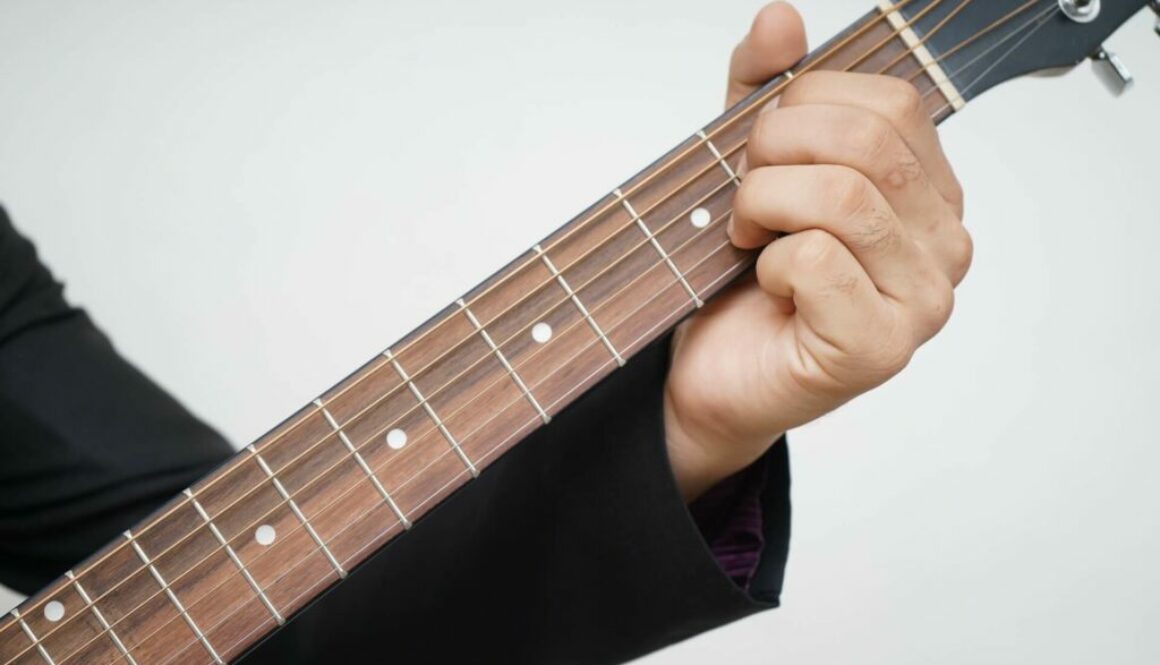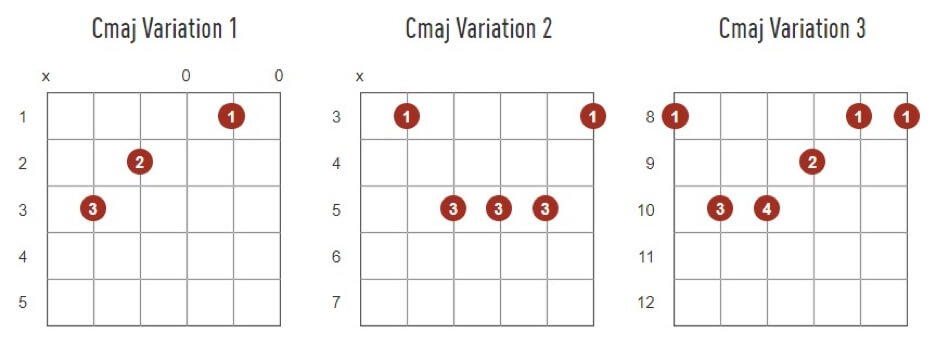Open Chords: The Place To Begin On Guitar

When a guitar string rings without any fingers down on the fretboard, we call that an “open” string. An open string is allowed to ring freely and will sound for a while if it is not muted (the word for using your hand to stop the ringing of the strings).
Open chords are the chords where some of the strings are ringing open within the chord. A guitar has six strings, and in most of the open chords, three fingers are down on the fretboard, and three of the strings are ringing open. On a guitar chord chart, you will see an “O” or “0” at the end of the fretboard indicating that there are no fingers down on that string.
Why start with open chords?
- Open chords are great for beginners for a few reasons. Open chords use just 2 or three fingers on the fretboard at once, making them a bit easier to form. They are played in the first few frets, so your hand is staying near the headstock of the guitar and not jumping around.
- Open chords teach you the “shapes” of guitar chords that will be used in all of your guitar playing. Open chords are sometimes considered the opposite of “barre” chords that are placed higher up the fretboard, but the barre chords will use the shape of the open chords you’ve already learned. Barre chords require the use of all four of your fingers (your pointer serves as the bar). Barre chords also require more familiarity with the fretboard than open chords do.
- Open chords build your knowledge of the names of the strings and the names of the notes near the neck of the guitar. When you learn the shape of the open chord, you are also learning the names of the notes you are playing. For example, when strumming an open G chord, you are playing two G notes at once, building awareness of where to find G on the guitar. When you play an open A chord, you strum from the A string up, building familiarity with where A lives on the guitar.
How to get started on open chords
A great way to get started is by using a guitar chord chart so you can see all of the chords at once to easily find what you need. It will look something like this:

Start off with the basics by learning the Major chords E, A, D, G, C, then move on to some Minor chords: Em, Am, Dm for example. For some more advanced chords you could try 7th chords and sus chords. All of which will be outlined in the chord chart. You can also use a chord finder if you are looking for a more specific chord.
How to read a chord chart
Read the charts from left to right, with left being the lowest, thickest string on your guitar, and right being the thinnest string closest to your knee. Look for the “O” at the top of the string to indicate no fingers on the fretboard for that string. Then see what strings need to be pushed down on which fret.
One important reminder: if the string has an “X” on top, it means not to strum that string when you play the chord, or to ‘mute’ that particular string when playing the chord. That means that your thumb or your pick will start on whatever string doesn’t have an X. The three open chords where this applies most are D Major (strum string 4 and up, the low E doesn’t fit into the chord), and C and A Major (strum string 5 and up for these chords to keep the root note in the bass).
Know the relationships: Each of the guitar strings (EADGBE) has an open chord (Major or minor) that corresponds with the six strings. It makes sense that many of the open chords start with an open string as the root (or bottom) note of the chord. For example, there are 2 E strings on your guitar, and an E Major and E minor chord can be played open with both E strings ringing freely. The A and D strings are also the root for both Major and minor open chords. The G string rings open in the middle of a G Major chord, and last there is an open B minor and B7 variant that are more infrequently used (the barre chord being more common).
Besides the open chords that are named after the open strings, the other frequently used open chord is C Major. Several of the Major and minor chords have a 7th variant that can also be played open, but typically we learn the Major and minor shapes before the 7th shapes.
How to combine the open chords
Let’s see how to combine the open chords together. Knowing the relationship between chords is the best way to start combining them. Combining the (major) I, IV, and V chords in a key is a great way to start building your playing ability. Then add in the (minor) ii or vi chords, and you’ll be able to play most songs in the rock and pop world!
Chords in music are written with Roman numerals, capital for Major and lowercase for minor. In the chart below are four Major keys where you can play many of the chords in a scale in an open position. The chord names in the highlighted font can be played open. (Don’t worry about the vii༠ not having open versions, it is a very infrequently used chord).
| I | ii | iii | IV | V | vi | vii𐩑 |
|---|---|---|---|---|---|---|
| D | Em | F#m | G | A | Bm | C#dim |
| G | Am | Bm | C | D | Em | F#dim |
| C | Dm | Em | F* (baby barre version) | G | Am | Bdim |
| A | Bm | Cm | D | E | F#m | G#dim |
The last thing to know about open chords: If any of this is intimidating, know that there are smaller versions of the open chords that use just the top 3 strings (the thinnest strings closest to your knee). Affectionately known as the “baby” chords, this is a great way to introduce a young student (2nd grade is usually a good place to start) or other novice to the basics of guitar playing, including depressing strings with enough pressure, changing chords, and strumming.
Conclusion
Open chords are the first chords you learn as a beginning guitarist. Once you get these basic chords down, you’ll be able to play hundreds of songs in rock and pop music. They are also a great way to build calluses, which will help you be able to play more! Master the open chords, and your journey to learning to play guitar will be well on its way.
